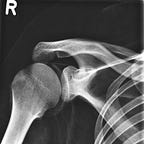Muscle Physiology
Classification
Muscle is classified in three different ways.
Striation
- Striated — Non-striated
Control
- Voluntary — Involuntary
Situation
- Skeletal — Cardiac
Composition
Many levels of sub-division
Muscles are composed of myocytes, myocytes are seperated from each other by fascia.
The entire muscle mass is encompassed in a connective tissue called the epimysium.
Hierarchy of muscle composition
- Muscle mass (epimysium coated)
- Perimysium
- Endomysium
- Myocyte
- Sarcoplasm
- Myofibril
Each myofibril consists of two bands, the light band (I — Isotropic), and the dark band (A — Anisotropic)
Myocyte structure
The myocyte is a cylinder with alternating Dark/Light bands, with a nucleus present.
The myofilaments exist in actin and myosin forms.
Muscle Contraction
I-bands move toward the M-Line of the H-Zone
Myosin and actin move closer together and bind.
This process is described by the crossbridge cycle
Crossbridge Cycle
- Myosin + Actin Bind
- Power-Stroke
- Rigor (myosin in low-energy state)
- ATP + Myosin head bind
- Myosin + Actin Unbind, with the use of ATP.
- Step 1 recurs.
Metabolic Classification
Slow oxidative, fast oxidative, and glycolytic skeletal muscle fibres differ in the following with regard to metabolism.
Oxidative Capacity
Both slow oxidative and fast oxidative have the same high oxidative capacity.
Glycolytic fibres have low oxidative capacity
Glycolytic Capacity
Conversely, slow and fast oxidative fibres have low glycolytic capacity, and glycolytic fibres have high glycolytic capacity.
Myosin ATPase Activity
Low in slow oxidative fibres, intermediate in fast oxidative fibres and high in glycolytic
Physiological Classification
Speed of contraction
high in the oxidative fibres and low in glycolytic.
Motor Unit Size
Slow to fast to glycolytic in order of smallest to largest.
